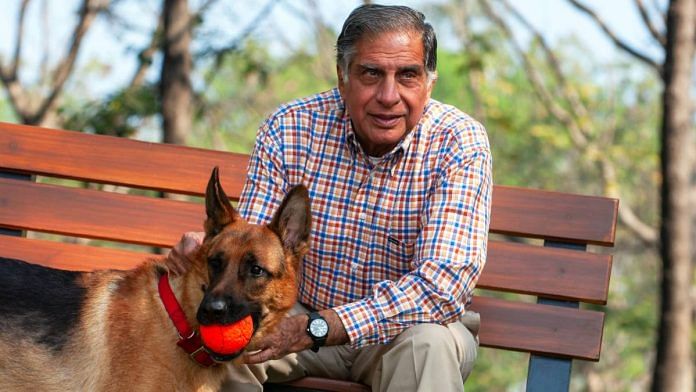Thank you dear subscribers, we are overwhelmed with your response.
Your Turn is a unique section from ThePrint featuring points of view from its subscribers. If you are a subscriber, have a point of view, please send it to us. If not, do subscribe here: https://theprint.in/subscribe/
Ratan Tata, a revered Indian industrialist, embodies the legacy of both the Tata Group and the Parsee community’s resilience. Like the Parsees, the Tatas overcame exile, loss, and adversity to rise as industrial pioneers. Despite challenges, including nationalization efforts by Feroze Khan Ghandy (Indira Nehru’s husband), the Tatas thrived, making a lasting impact on India’s economy and solidifying their place in the nation’s industrial and cultural history. Their charitable trust and donations back to society is beyond exemplary.
The Parsee Exile: A Story of Survival
The Parsee community, originally Zoroastrians from Iran, fled to India during the 7th century Islamic conquest to escape religious persecution. Settling mainly in Gujarat, they were allowed to practice their faith freely, thanks to India’s tradition of religious tolerance, which dates back to Guru Nanak’s travels to Baghdad. The Tatas, like many Parsees, trace their roots to this exile. By the 1800s, some Parsee families settled in Rawalpindi, including the Tatas, who survived partly due to local farmers’ support, including my father’s ancestral farm nearby. This cultural exchange fostered goodwill and allowed these industrious families to flourish.
Building an Industrial Empire: The Tata Legacy
Ratan Tata’s legacy is a reflection of the resilience shown by the Tata family across centuries. The Tatas founded their industrial empire under the leadership of Jamsetji Tata in the 19th century. Starting with a textile mill in Nagpur in 1877, the Tata family eventually built one of India’s largest conglomerates, expanding into sectors such as steel, automobiles, and technology. They contributed to India’s industrialization in a manner that not only built wealth but also focused on social good.
When India gained independence in 1947, the Tatas were a prominent name in industry. However, the Partition caused immense disruption, much like it did for my own family, who lost ancestral lands in Lahore’s Shalimar Gardens for my mom’s family and near Rawalpindi for my father’s family. This period of upheaval could have destroyed the Tatas as well, but their resilience saw them through. Unlike many others who lost everything in the division of India, the Tatas adapted and expanded their operations across the new India.
The Kohinoor and the Loss of Ancestral Lands
The Tatas’ struggles mirror other historical losses that resonate with India’s rich history, such as the tragic transfer of the Kohinoor diamond from India to the British Crown. Once part of Maharaja Ranjit Singh’s empire in Lahore, the Kohinoor was lost to the British after the fall of the Sikh Empire and was taken to the United Kingdom by Maharaja Duleep Singh. This was not just a loss of a jewel but a symbol of the stripping away of India’s wealth during British rule. Similarly, my own family’s ancestral lands in Lahore, tied to the rich agricultural heritage of Punjab, were lost during the Partition.
The Tatas, however, faced their own modern-day version of such loss when the Indian government, under Prime Minister Nehru’s and his daughter’s failed leadership, as they attempted to nationalize key industries, including Air India and Tata Locomotives.
The Attempted Destruction of the Tata Empire
One of the biggest challenges to the Tata empire came from within India’s political system, not from external forces. Feroze Khan Ghandy, husband of Indira Nehru, played a key role in the nationalization of Tata Locomotives and Air India. Feroze, originally from a Parsi family, adopted the surname “Gandhi” to align with Mahatma Gandhi’s legacy, a move seen by many as politically motivated.
In the 1960s and 1970s, Indira Gandhi’s government nationalized major industries, including Tata enterprises, dealing a significant blow to the family. Tata Locomotives and Air India, founded by J.R.D. Tata, were taken over. Despite these setbacks, Ratan Tata, who became chairman in 1991, revitalized the group through global acquisitions like Jaguar Land Rover. His leadership transformed Tata into a global conglomerate, reinforcing the resilience that defined the Tata legacy.
Conclusion: A Legacy of Endurance
The Tatas’ legacy is one of endurance and reinvention. From their ancestors’ exile from Iran to their contributions to India’s industrial development, and through the challenges posed by government policies, the Tata family has repeatedly shown resilience. Ratan Tata, in particular, exemplifies this spirit. His leadership not only preserved the Tata empire but expanded it into a global brand known for its ethical business practices and corporate social responsibility.
In many ways, the journey of the Tata family mirrors that of India itself—a story of survival, loss, and eventual triumph. Both have endured political upheavals, territorial losses, and moments of crisis, but have emerged stronger. For the Tata family, this resilience has allowed them to play a pivotal role in shaping India’s modern industrial landscape, ensuring that their legacy continues to thrive.
Akshay Sharma is a media and tech consultant, recognized for his extensive work with regulatory bodies such as Ofcom, FCC, and CRTC. As a former smartphone CTO and Value Stream Management CTO on Governance Platforms, Akshay serves as a board member for Somy Ali’s NGO, No More Tears, where he collaborates on initiatives aimed at ending domestic violence and human trafficking. He has advised Tata’s Tejas Networks, Tata Com, Tata Com’s TCTS division, Tata TCS, Tata Technologies, Tata Elxsi, and Tata Tanishq while at Gartner. His views are personal.
These pieces are being published as they have been received – they have not been edited/fact-checked by ThePrint.


